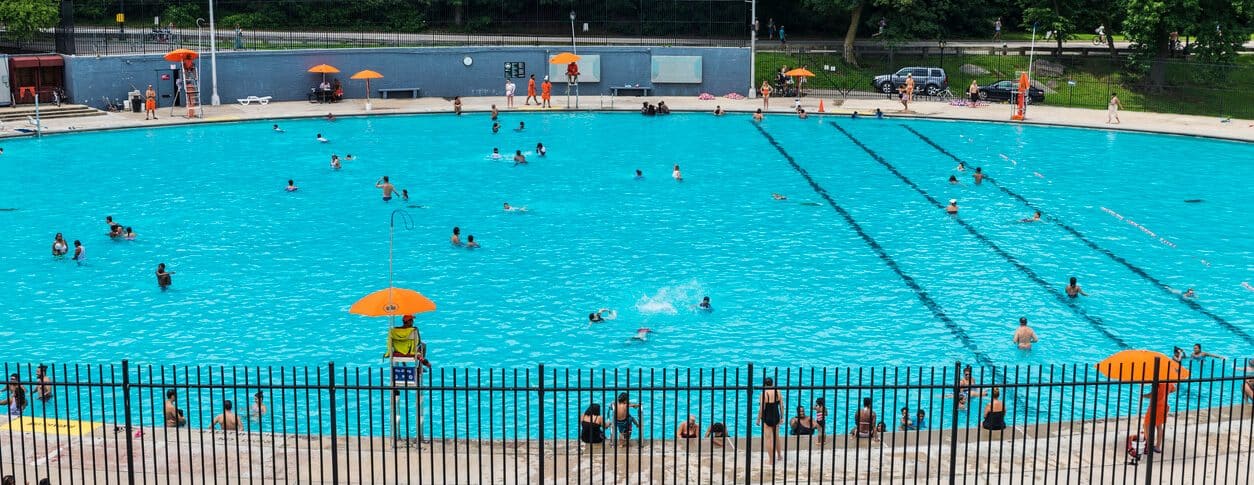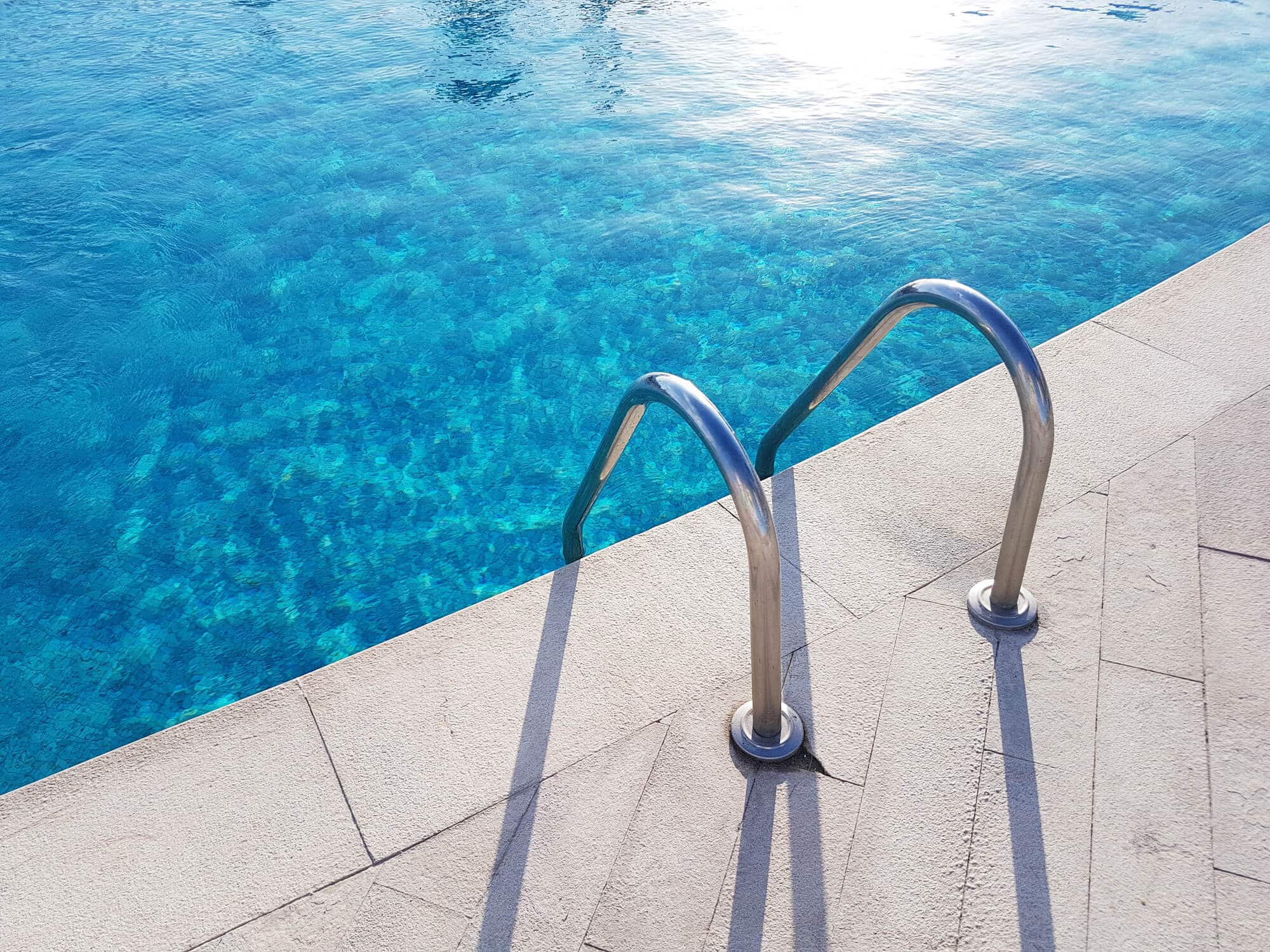Swimming pool accidents range from slips and falls to diving mishaps. They include drownings, electrocutions and drain entrapments, and even chemical exposure.
Drowning Deaths
“Not including boating incidents, on average about 10 people die from drowning every day in the United States,” warns the National Safety Council (NSC) (1)
NSC also notes, “Statistics point to drowning as a leading cause of death for young children – mostly due to children falling into a pool or being left alone in the bathtub.” (2)
New York is ranked among the top 7 states for drownings, with 907 deaths from 2009 to 2018, according to End Drowning Now. (3)

New York Pool Facts and Statistics
A New York State Department of Health report on drownings at regulated facilities indicates 208 drownings at pools and beaches. More than half of those drownings, 109, were in pools. (4)
Other findings from the report: (5)
- Roughly 86% of all drownings occurred in pools.
- More drownings occurred during summer.
- Drownings happened more frequently from 4–6 p.m.
- Approximately 100 drownings were in water depths of less than 5 feet.
- Males were 4 times more likely to drown than females.
- 47% of drowning victims were able to swim.
- Blacks had a higher rate of drownings than Hispanics and whites.
Common Swimming Accidents and Injuries
There are a number of common swimming accidents which result in injuries. These include:
Slips and Falls
Slips and falls can result in scrapes, bruises, broken bones, or head trauma. These types of accidents often occur when someone is running in a pool area. Wet surfaces increase the chances of this happening. (6)
Diving and Jumping
Diving or jumping into shallow pool ends can cause serious head and spinal injuries, especially if jumping in headfirst. Even if jumping in feet first, the resulting muscle and joint sprains injuries can be painful. (7)
Drownings
Drownings are the leading cause of unintentional death among very young children, says the U.S. Consumer Product Safety Commission (CPSC). The Commission’s “data shows that there were, on average, 379 reported pool-or-spa-related fatal drownings per year for 2015 through 2017, involving children younger than 15 years old.” (8)
“In addition to fatal drownings, CPSC’s new data shows that there were an estimated 6,700 pool-or-spa-related, hospital emergency department-treated, nonfatal child drowning injuries each year for 2017 through 2019. This is the equivalent of about 18 children every day, 365 days a year,” the Commission continues. (9)
Drownings
CPSC’s new data shows there were an estimated 6,700 pool-or-spa-related, hospital emergency department-treated, nonfatal child drowning injuries each year for 2017 through 2019.”
Drowning are often fatal, but nonfatal drownings occur and can lead to organ damage. Victims of nonfatal drownings may suffer brain damage caused by a lack of oxygen to the brain (hypoxic brain injury). The damage can be severe and have long-term consequences, like memory problems, learning disabilities, or permanent loss of function (vegetative state). (10)
Electric Shock Drowning
Electric shock drowning (ESD) can lead to death. The Electrical Shock Drowning Prevention Association says ESD results from electrical current passing through the body causing “skeletal muscular paralysis, rendering the victim unable to help himself / herself, while immersed in fresh water, eventually resulting in drowning of the victim.” In the water, higher levels of current may also cause electrocution. (11)
Pool Drain Entrapment
Pool drain entrapment occurs when strong suction is created by water rapidly flowing through pool drains, says the International Association of Certified Home Inspectors. When this happens, young children can be trapped, which can lead to serious injuries or death. Also, drain covers that are loose or missing can lead to injuries. (12)
There are several types of drain entrapment according to the CPSC: (13)
- Body entrapment: body or body part held down by suction.
- Evisceration: disembowelment can occur when sitting on a drain.
- Hair entrapment: hair caught in faulty or broken drain cover.
- Limb entrapment: arm or leg gets stuck in drain.
- Mechanical entrapment: when jewelry or clothing get caught in a drain.
Chemical Injuries
Chemical injuries occur when chemicals are added to swimming pools improperly, says the Water Quality & Health Council. “Between 2015 and 2017, pool chemical injuries led to approximately 13,508 emergency department visits.” (14)
Chemicals normally added to swimming pools include chlorine and disinfectants. These must be added in the right amounts. When the balance of these chemicals is off, swimmers may experience irritations of the eyes, ears, airways, and skin. Creating a caustic pool can end up requiring a call to Poison Control. The inhalation or ingestion of chemical fumes, vapors and gases can cause respiratory injuries. (15)
Were you or someone you know injured in a swimming pool accident? You may be eligible for compensation.
Get a Free Case ReviewCauses of Swimming Accidents
Among the Centers for Disease Control and Prevention’s list of causes of swimming accidents are: (16)
- Alcohol use.
- Incorrect depth markers.
- Lack of barriers: pool fencing and gates.
- Lack of close supervision, especially of young children.
- Lack of swimming ability.
- Slippery decks and surfaces.
Pool Accidents and Premises Liability
Premises liability is a legal concept. It applies to property owners when people who are legally permitted to be on their property become injured while on that property.
The New York City Bar says the “owner is liable for your injuries if the owner’s negligence caused your injury.” (17)
It adds, “While premises liability includes slip/trip & fall situations, it is broader because it addresses any unsafe condition and resulting injury, whether caused by a fall or otherwise.” (18)
Safety Violations
Where swimming pools are concerned, property owners have a legal duty – duty of care – to keep their pools safe. When they fail, they can be sued.
Examples of a property owner’s failure to maintain a safe pool include:
- Absence of warning signs.
- Broken equipment.
- Failure to provide trained lifeguards.
- Improper pool maintenance, including appropriate chemical balance in pool.
- Lack of proper fencing, gates, or both around pool areas.
- Damaged areas or areas under repair.
The person suing (you, the plaintiff), must show the court their injury was caused by the property owner’s negligence.
Pool Trespassers
In general, trespassers are not owed a duty of care by a property owner and the owner cannot be held responsible for their injuries. But there are exceptions. (19)
A trespasser may be on a property and the owner knows this but allows the trespasser to remain. If so, then the owner is responsible for any injuries the trespasser sustains while on the property. (20)
If a trespasser is a child and some condition on the property is deemed “attractive” the owner is responsible for injuries while on the property. (21)
For example, the gate to a pool is unlocked. The pool has very little water in it and there is a blow-up seahorse floating at the bottom. A child climbs in to play with the float and trespasses, without understanding the danger.
What to Do After a Swimming Pool Accident
There are several things you should do immediately after a swimming pool accident:
- Seek medical attention. This helps document your injuries and expenses.
- Take cell phone pictures at the scene of the accident.
- Get the names and contact information of witnesses and police officers on scene.
- Obtain a copy of any police or incident reports.
- Contact an attorney who can help you put together a case.
How W&L Can Help
W&L has an experienced team of attorneys who win trial verdicts and negotiate settlements for people who have suffered harm due to negligence.
We successfully helped get:
- $10 million for a teenage boy partially blinded during a recreational activity.
- High six figures financial compensation for a woman seriously hurt due to someone’s negligence.
